Showing Spotlights 169 - 176 of 237 in category All (newest first):
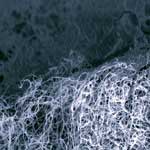 Electrically conductive composite materials capable of substantial elastic stretch and bending - conductive rubbers - is an industrially important field. The composites are needed for such applications as smart clothing, flexible displays, stretchable circuits, strain gauges, implantable devices, high-stroke microelectromechanical systems, and actuators. A variety of approaches involving carbon nanotubes and elastic polymers have been suggested for the fabrication of conductive elastic composites. Various studies indicated that high loading of CNTs or other conductive additives into the polymer was necessary to obtain a highly conducting composite. A research team has now demonstrated that a combination of high stretchability and high electrical conductivity can be obtained for composites prepared from three-dimensional CNT structures.
Electrically conductive composite materials capable of substantial elastic stretch and bending - conductive rubbers - is an industrially important field. The composites are needed for such applications as smart clothing, flexible displays, stretchable circuits, strain gauges, implantable devices, high-stroke microelectromechanical systems, and actuators. A variety of approaches involving carbon nanotubes and elastic polymers have been suggested for the fabrication of conductive elastic composites. Various studies indicated that high loading of CNTs or other conductive additives into the polymer was necessary to obtain a highly conducting composite. A research team has now demonstrated that a combination of high stretchability and high electrical conductivity can be obtained for composites prepared from three-dimensional CNT structures.
May 21st, 2010
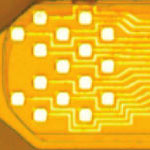 One of the most neglected aspects in the nanoelectronics field is the problem of wiring. How do we wire individual nanoelectronic devices within a nanointegrated circuit together? Furthermore, how do we extract and input information from such a circuit - i.e. how do we let it communicate with the outside world? Researchers at Caltech present a method for multiplexing the electrical signals from potentially tens of thousands of nanoscale sensors onto a single optical output, using piezoelectric nanoscale mechanical resonators. This work is a step closer to building miniscule, highly integrated sensor arrays that are untethered from the external environment.
One of the most neglected aspects in the nanoelectronics field is the problem of wiring. How do we wire individual nanoelectronic devices within a nanointegrated circuit together? Furthermore, how do we extract and input information from such a circuit - i.e. how do we let it communicate with the outside world? Researchers at Caltech present a method for multiplexing the electrical signals from potentially tens of thousands of nanoscale sensors onto a single optical output, using piezoelectric nanoscale mechanical resonators. This work is a step closer to building miniscule, highly integrated sensor arrays that are untethered from the external environment.
Apr 30th, 2010
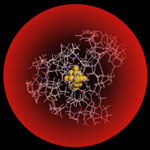 Nanotechnology can play an important role in water treatment and an active emerging area of research is the development of novel nanomaterials with increased affinity, capacity, and selectivity for heavy metals and other contaminants. The benefits from use of nanomaterials may derive from their enhanced reactivity, surface area and sequestration characteristics. In addition to heavy-metal ions such as mercury or lead, toxic anions like cyanide are of concern to environmental managers. Whereas toxic metals induce diseases by accumulating in the body, cyanide can directly cause death in as short a period as minutes by directly affecting the central nervous system. Researchers in China have now developed a relatively simple, cost-effective, environmentally friendly and yet highly sensitive cyanide sensor to test water samples.
Nanotechnology can play an important role in water treatment and an active emerging area of research is the development of novel nanomaterials with increased affinity, capacity, and selectivity for heavy metals and other contaminants. The benefits from use of nanomaterials may derive from their enhanced reactivity, surface area and sequestration characteristics. In addition to heavy-metal ions such as mercury or lead, toxic anions like cyanide are of concern to environmental managers. Whereas toxic metals induce diseases by accumulating in the body, cyanide can directly cause death in as short a period as minutes by directly affecting the central nervous system. Researchers in China have now developed a relatively simple, cost-effective, environmentally friendly and yet highly sensitive cyanide sensor to test water samples.
Apr 8th, 2010
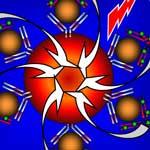 In many diagnostic processes, the detection of several protein markers is required. Rather than performing several sequential analysis steps, a multiplexed approach allows the simultaneous measurement of multiple biomarkers from the same blood sample. The convergence of nanotechnology, microtechnology, microfluidics, photonics, signal processing, and proteomics allows for the development of increasingly sophisticated and effective multiplexed point-of-care diagnostic devices. The detection of protein biomarkers can done with an optical multiplexing approach that uses dye particles of different colors. In contrast to conventional fluorescence dyes, quantum dots generate a much more powerful fluorescent signal which provides a large increase in sensitivity compared to other methods. Quantum dots are also available in multiple colors, allowing the investigators to tag each antibody with a uniquely colored quantum dot. Researchers have now demonstrated a novel and fast quantum dot-based FRET technique that is suitable for multiplexed ultrasensitive detection.
In many diagnostic processes, the detection of several protein markers is required. Rather than performing several sequential analysis steps, a multiplexed approach allows the simultaneous measurement of multiple biomarkers from the same blood sample. The convergence of nanotechnology, microtechnology, microfluidics, photonics, signal processing, and proteomics allows for the development of increasingly sophisticated and effective multiplexed point-of-care diagnostic devices. The detection of protein biomarkers can done with an optical multiplexing approach that uses dye particles of different colors. In contrast to conventional fluorescence dyes, quantum dots generate a much more powerful fluorescent signal which provides a large increase in sensitivity compared to other methods. Quantum dots are also available in multiple colors, allowing the investigators to tag each antibody with a uniquely colored quantum dot. Researchers have now demonstrated a novel and fast quantum dot-based FRET technique that is suitable for multiplexed ultrasensitive detection.
Feb 17th, 2010
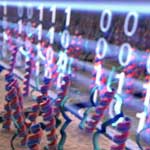 Much of today's genetic research and diagnostics uses tools and technologies enabled by DNA's ability to bind to its complementary strand in a sequence specific manner. For biologists studying molecular mechanisms inside cells, this information helps to quantify the expression levels of genes. Detection of the binding - or hybridization - of DNA strands is at the heart of modern medicine. The technology for detecting DNA hybridization mainly relies on the use of fluorescent labels. The complementary strand coming from the sample bears a label, so detection of florescence signal indicates hybridization. While this may sound straightforward, it has major limitations. Researchers have now reported a new technique for genetic analysis using nanomechanical response of hybridized DNA/RNA molecules. This new technique is several orders of magnitude more sensitive than other approaches and it is a lot simpler to use.
Much of today's genetic research and diagnostics uses tools and technologies enabled by DNA's ability to bind to its complementary strand in a sequence specific manner. For biologists studying molecular mechanisms inside cells, this information helps to quantify the expression levels of genes. Detection of the binding - or hybridization - of DNA strands is at the heart of modern medicine. The technology for detecting DNA hybridization mainly relies on the use of fluorescent labels. The complementary strand coming from the sample bears a label, so detection of florescence signal indicates hybridization. While this may sound straightforward, it has major limitations. Researchers have now reported a new technique for genetic analysis using nanomechanical response of hybridized DNA/RNA molecules. This new technique is several orders of magnitude more sensitive than other approaches and it is a lot simpler to use.
Dec 21st, 2009
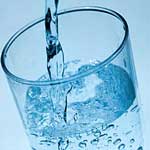 Safe drinking water has been and increasingly will be a pressing issue for communities around the world. In developed countries it is about keeping water supplies safe while in the rest of the world it is about making it safe. The potential impact areas for nanotechnology in water applications are divided into three categories - treatment and remediation, sensing and detection, and pollution prevention. Within the category of sensing and detection, of particular interest is the development of new and enhanced sensors to detect biological and chemical contaminants at very low concentration levels. Testing of water against a spectrum of pathogens can potentially reduce the likelihood of many diseases from cancer to viral infections.
Safe drinking water has been and increasingly will be a pressing issue for communities around the world. In developed countries it is about keeping water supplies safe while in the rest of the world it is about making it safe. The potential impact areas for nanotechnology in water applications are divided into three categories - treatment and remediation, sensing and detection, and pollution prevention. Within the category of sensing and detection, of particular interest is the development of new and enhanced sensors to detect biological and chemical contaminants at very low concentration levels. Testing of water against a spectrum of pathogens can potentially reduce the likelihood of many diseases from cancer to viral infections.
Dec 8th, 2009
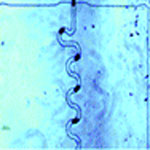 A lot of the scientific knowledge in chemistry and biology comes from experiments on ensembles of molecules by which a vast number of duplicate behaviors are investigated and averaged responses are recorded. Especially the ability to make measurements at the single molecule level provides crucial information about biological and chemical systems. This research depends on molecular manipulation technologies that are able to isolate individual molecules and sequentially transport them for measurement and, potentially, manipulation. To this end, generation and manipulation of small, highly monodisperse droplets have received a lot of attention in the biotech community recently. Using a simple droplet generator chip, scientists can generate millions of droplets in a short amount of time. Each individual droplet is isolated from another droplet, hence, meaning that a million droplets constitute a million individual microreactors running a million reactions simultaneously.
A lot of the scientific knowledge in chemistry and biology comes from experiments on ensembles of molecules by which a vast number of duplicate behaviors are investigated and averaged responses are recorded. Especially the ability to make measurements at the single molecule level provides crucial information about biological and chemical systems. This research depends on molecular manipulation technologies that are able to isolate individual molecules and sequentially transport them for measurement and, potentially, manipulation. To this end, generation and manipulation of small, highly monodisperse droplets have received a lot of attention in the biotech community recently. Using a simple droplet generator chip, scientists can generate millions of droplets in a short amount of time. Each individual droplet is isolated from another droplet, hence, meaning that a million droplets constitute a million individual microreactors running a million reactions simultaneously.
Nov 25th, 2009
 Researchers have developed a self-sensing nanotechnology composite material for traffic monitoring by using piezoresistive multi-walled carbon nanotubes as an admixture. In experiments, they studied the response of the piezoresistive properties of this composite to compressive stress and they investigated with vehicular loading experiments the feasibility of using self-sensing CNT/cement composite for traffic monitoring. This nanocomposite cement has great potential for traffic monitoring use such as in vehicle detection, weigh-in-motion measurement and vehicle speed detection. An interesting aspect of this work is that, from the eventual traffic application's point of view, the pavement itself would become the traffic detection, thus eliminating the need for separate traffic flow detection sensors.
Researchers have developed a self-sensing nanotechnology composite material for traffic monitoring by using piezoresistive multi-walled carbon nanotubes as an admixture. In experiments, they studied the response of the piezoresistive properties of this composite to compressive stress and they investigated with vehicular loading experiments the feasibility of using self-sensing CNT/cement composite for traffic monitoring. This nanocomposite cement has great potential for traffic monitoring use such as in vehicle detection, weigh-in-motion measurement and vehicle speed detection. An interesting aspect of this work is that, from the eventual traffic application's point of view, the pavement itself would become the traffic detection, thus eliminating the need for separate traffic flow detection sensors.
Oct 9th, 2009
 Electrically conductive composite materials capable of substantial elastic stretch and bending - conductive rubbers - is an industrially important field. The composites are needed for such applications as smart clothing, flexible displays, stretchable circuits, strain gauges, implantable devices, high-stroke microelectromechanical systems, and actuators. A variety of approaches involving carbon nanotubes and elastic polymers have been suggested for the fabrication of conductive elastic composites. Various studies indicated that high loading of CNTs or other conductive additives into the polymer was necessary to obtain a highly conducting composite. A research team has now demonstrated that a combination of high stretchability and high electrical conductivity can be obtained for composites prepared from three-dimensional CNT structures.
Electrically conductive composite materials capable of substantial elastic stretch and bending - conductive rubbers - is an industrially important field. The composites are needed for such applications as smart clothing, flexible displays, stretchable circuits, strain gauges, implantable devices, high-stroke microelectromechanical systems, and actuators. A variety of approaches involving carbon nanotubes and elastic polymers have been suggested for the fabrication of conductive elastic composites. Various studies indicated that high loading of CNTs or other conductive additives into the polymer was necessary to obtain a highly conducting composite. A research team has now demonstrated that a combination of high stretchability and high electrical conductivity can be obtained for composites prepared from three-dimensional CNT structures.
 Subscribe to our Nanotechnology Spotlight feed
Subscribe to our Nanotechnology Spotlight feed





